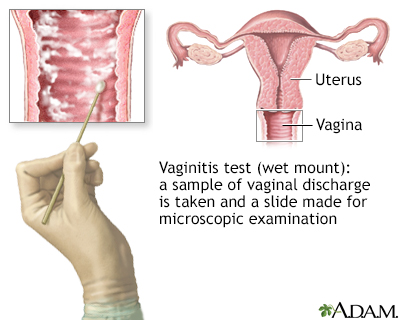Vaginitis test - wet mount
Wet prep - vaginitis; Vaginosis - wet mount; Trichomoniasis - wet mount; Vaginal candida - wet mount
The vaginitis wet mount test is a test to detect an infection of the vagina.
Images



How the Test is Performed
This test is done in your health care provider's office.
- You lie on your back on the exam table. Your feet are supported by footrests.
- The provider gently inserts an instrument (speculum) into the vagina to hold it open and view inside.
- A sterile, moist cotton swab is gently inserted into the vagina to take a sample of discharge.
- The swab and speculum are removed.
Your provider may examine the discharge under a microscope. Or, the discharge is sent to a lab. There, it is placed onto a slide. It is then viewed under a microscope and checked for signs of infection.
How to Prepare for the Test
Follow any instructions from your provider on preparing for the test. This may include:
- In the 2 days before the test, do not use creams or other medicines in the vagina.
- Do not douche. (You should never douche. Douching can cause infection of the vagina or uterus.)
How the Test will Feel
There may be slight discomfort when the speculum is inserted into the vagina.
Why the Test is Performed
The test looks for the cause of vaginal irritation and discharge.
Normal Results
A normal test result means there are no signs of an infection.
Normal value ranges may vary slightly among different laboratories. Some labs use different measurements or test different samples. Talk to your provider about the meaning of your specific test results.
What Abnormal Results Mean
Abnormal results mean there is an infection. The most common infections are due to one or a combination of the following:
- Bacterial vaginosis. Bacteria that normally live in the vagina overgrow, causing a heavy, white, fishy-smelling discharge and possibly a rash, painful intercourse, or odor after intercourse.
- Trichomoniasis, a sexually transmitted disease.
- Vaginal yeast infection.
Risks
There are no risks with this test.
Related Information
Vaginal drynessVaginal itching and discharge - adult and adolescent
Vaginal yeast infection
Trichomoniasis
Cervix
References
Eckert LO, Lentz GM. Genital tract infections: vulva, vagina, cervix, toxic shock syndrome, endometritis, and salpingitis. In: Gershenson DM, Lentz GM, Valea FA, Lobo RA, eds. Comprehensive Gynecology. 8th ed. Philadelphia, PA: Elsevier; 2022:chap 23.
Plourde AR, Beavis KG. Specimen collection and handling for diagnosis of infectious diseases. In: McPherson RA, Pincus MR, eds. Henry's Clinical Diagnosis and Management by Laboratory Methods. 24th ed. Philadelphia, PA: Elsevier; 2022:chap 66.
BACK TO TOPReview Date: 7/8/2023
Reviewed By: Linda J. Vorvick, MD, Clinical Professor, Department of Family Medicine, UW Medicine, School of Medicine, University of Washington, Seattle, WA. Also reviewed by David C. Dugdale, MD, Medical Director, Brenda Conaway, Editorial Director, and the A.D.A.M. Editorial team.

Health Content Provider
06/01/2025
|
A.D.A.M., Inc. is accredited by URAC, for Health Content Provider (www.urac.org). URAC's accreditation program is an independent audit to verify that A.D.A.M. follows rigorous standards of quality and accountability. A.D.A.M. is among the first to achieve this important distinction for online health information and services. Learn more about A.D.A.M.'s editorial policy, editorial process and privacy policy. A.D.A.M. is also a founding member of Hi-Ethics. This site complied with the HONcode standard for trustworthy health information from 1995 to 2022, after which HON (Health On the Net, a not-for-profit organization that promoted transparent and reliable health information online) was discontinued. |
The information provided herein should not be used during any medical emergency or for the diagnosis or treatment of any medical condition. A licensed medical professional should be consulted for diagnosis and treatment of any and all medical conditions. Links to other sites are provided for information only -- they do not constitute endorsements of those other sites. © 1997- 2025 A.D.A.M., a business unit of Ebix, Inc. Any duplication or distribution of the information contained herein is strictly prohibited.
